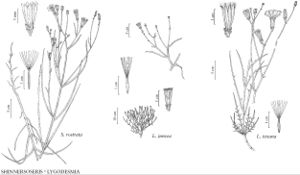Difference between revisions of "Lygodesmia juncea"
Fl. Bor.-Amer. 1: 295. 1833.
FNA>Volume Importer |
FNA>Volume Importer |
||
| Line 53: | Line 53: | ||
|publication year=1833 | |publication year=1833 | ||
|special status= | |special status= | ||
| − | |source xml=https://jpend@bitbucket.org/aafc-mbb/fna-data-curation.git/src/ | + | |source xml=https://jpend@bitbucket.org/aafc-mbb/fna-data-curation.git/src/f50eec43f223ca0e34566be0b046453a0960e173/coarse_grained_fna_xml/V19-20-21/V19_599.xml |
|tribe=Asteraceae tribe Cichorieae | |tribe=Asteraceae tribe Cichorieae | ||
|genus=Lygodesmia | |genus=Lygodesmia | ||
Revision as of 20:19, 16 December 2019
Perennials, 10–35(–70) cm (in bushy clumps); taproots deep, vertical, rhizomes branched, woody. Stems erect to ascending or decumbent, green, glaucous, much branched from bases and distally, strongly striate, glabrous (often bearing round galls). Leaves (basal not in rosettes, absent at flowering); proximal blades linear, 5–30(–60) × 1–2(–4) mm, margins entire, apices acute, faces glabrous; cauline reduced to subulate scales. Heads (1–50+) borne singly or in corymbiform arrays. Involucres cylindric, 10–16 × 4–6 mm, apices spreading. Calyculi of 8, ovate to linear bractlets 2–4 mm, margins erose-ciliate (faces glabrous). Phyllaries 5(–7), linear, 10–15 mm, margins scarious, apices acute or obtuse, not appendaged, faces glabrous. Florets usually 5; corollas usually light pink to lavender, rarely white, 18–20 mm, ligules 3–4 mm wide. Cypselae 6–10 mm, weakly striate, glabrous; pappi 6–9 mm. 2n = 18.
Phenology: Flowering Jun–Sep.
Habitat: High Plains, rolling short-grass prairies, blufftop prairies, loess hills, sandy to silty soils, disturbed sites, railroads, roadsides, barren areas
Elevation: 600–2300 m
Distribution

Alta., B.C., Man., Sask., Ariz., Ark., Colo., Idaho, Ind., Iowa, Kans., Minn., Mo., Mont., Nebr., Nev., N.Mex., N.Dak., Okla., S.Dak., Tex., Utah, Wash., Wis., Wyo.
Discussion
Lygodesmia juncea is the most widespread species of the genus, occurring throughout the High Plains region of North America. It is easily distinguished by its bushy habit, greatly reduced cauline leaves, relatively small heads and involucres, and phyllaries lacking appendages. Mature cypselae are rarely found on this species, and the plants are presumably sterile and reproduce mainly by vegetative means. Many specimens have round galls to 10 mm diameter on the stems, produced by solitary wasps and apparently unique to this species.
Selected References
None.
